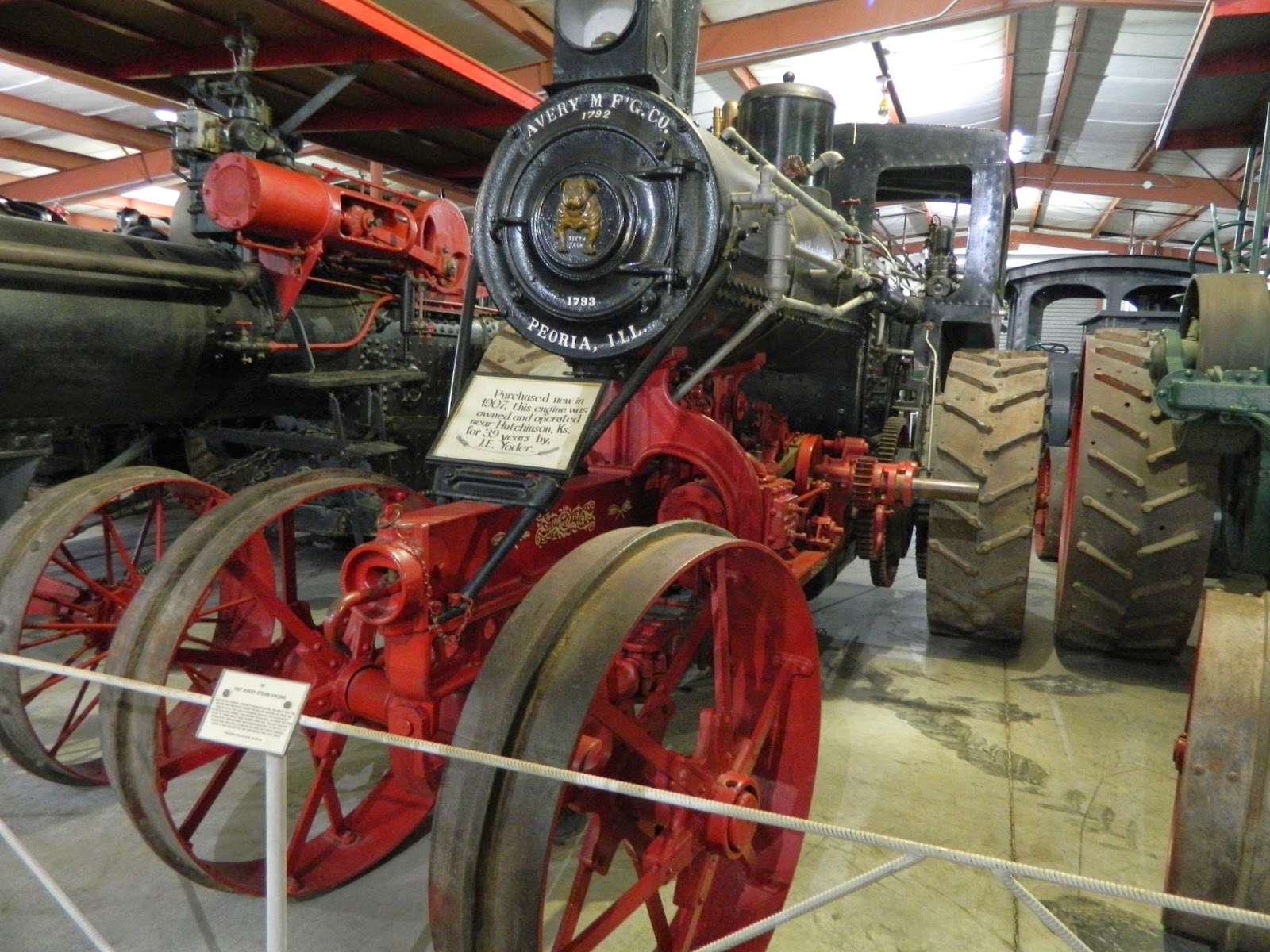This steam engine tractor, sometimes called a steam engine or steam traction engine, was made by the Avery Company in Peoria, Illinois. Part of the company's Bulldog line, this steam engine tractor differs significantly from its neighbors here at Stuhr Museum. This steam engine tractor is undermounted, meaning the gears, flywheel, and cylinders are mounted below the boiler. As a result of this unique design implementation, this Avery steam engine tractor looks much like a steam locomotive.
This particular steam engine tractor was reportedly purchased by J. E. Yoder in 1907 and was still in use near Yoder, Kansas, in the 1950s. It was teamed up with a "Yellow Fellow" Separator during the threshing season, the same Avery separator used with Avery steam and gas tractors across the North American prairie.
 |
| Avery advertisement with steam engine and "Yellow Fellow" Separator, from Thresherman's Review and Power Farming, vol. XXII, no. 7 (July 1913), p. 34. |
The maker of this steam engine, the Avery Company, was founded by Robert H. and Cyrus M. Avery, both born and raised in Galesburg, Illinois. Robert, the older of the two brothers, enlisted to fight for the Union during the American Civil War. In 1862, he joined Company A of the 77th Illinois Infantry, eventually becoming a sergeant. During his first couple years, he served in the Army of the Mississippi, participating in the siege of Vicksburg as well as the fighting at Arkansas Post, Jacksonville, and Shreveport. In August, 1864, Robert was captured by Confederates and was held prisoner for about eight-and-a-half months in a variety of places, including about five-and-a-half months in Andersonville. While waiting in prison, Robert developed ideas for farm implements, including a cultivator, and possibly a stalk cutter and a corn planter. When he was released after the war, Robert eventually made his way back to Illinois where he joined with his brother, Cyrus, to start a company and to make his ideas a reality.
By the early 1870s, they had established R. H. & C. M. Avery in Galesburg. They found a large and ready market for their implements and, after about a decade in Galesburg, they found they needed to move to larger and better facilities. In 1882, the Avery brothers relocated their business to Peoria and had a new factory built next to the Chicago, Rock Island & Pacific Railroad line. In 1883, they organized and renamed their venture the Avery Planter Company. During the next several years, the company continued to grow, employing about three hundred workers by 1890. Robert died in 1892, but Cyrus continued to lead the company into the twentieth century. In 1900, Cyrus reorganized the growing company as the Avery Manufacturing Company. After Cyrus’ death in 1905, J. B. Bartholomew took over the company, reorganizing it again as the Avery Company in 1907.
In 1912, the Avery Company plant covered about twenty-seven acres, including nearly six-and-a-half acres of floor space in the factory and warehouses. The company employed about 1,300 workers and made a wide variety of products, including steam traction engines (such as the one here in Stuhr Museum’s exhibit), gasoline tractors (two can be found in this exhibit), threshing machines, farm wagons, riding and walking cultivators, stalk cutters, corn planters (including one here in Stuhr's exhibit), and the “Self-Lift” gang plow (one can be found outside this building). The Avery Company sold their products across the United States, as well as to markets in Canada, Mexico, Brazil, the Argentine Republic, Portugal, Austria-Hungary, Russia, Sweden, Egypt, China, the Philippines, and Cuba.
In 1912, the Avery Company plant covered about twenty-seven acres, including nearly six-and-a-half acres of floor space in the factory and warehouses. The company employed about 1,300 workers and made a wide variety of products, including steam traction engines (such as the one here in Stuhr Museum’s exhibit), gasoline tractors (two can be found in this exhibit), threshing machines, farm wagons, riding and walking cultivators, stalk cutters, corn planters (including one here in Stuhr's exhibit), and the “Self-Lift” gang plow (one can be found outside this building). The Avery Company sold their products across the United States, as well as to markets in Canada, Mexico, Brazil, the Argentine Republic, Portugal, Austria-Hungary, Russia, Sweden, Egypt, China, the Philippines, and Cuba.
Notes
A nice narrative regarding Avery's undermounted steam engine tractors can be found on the Saskatchewan Western Development Museum's website.For a brief biography of Robert H. Avery, including details about his Civil War experiences, see Portrait and Biographical Album of Peoria County, Illinois. Volume 2. Containing Full Page Portraits and Biographical Sketches of Prominent and Representative Citizens of the County Together with Portraits and Biographies of All the Presidents of the United States and Governors of the State (Chicago: Biographical Publishing Co., 1890), pp. 951-952.
Much of the narrative here can be found in individual biographies found in Peoria City and County, Illinois: A Record of Settlement, Organization, Progress and Achievement, vol. II (Chicago: The S. J. Clarke Publishing Company, 1912), pp. 27, 181-183, 246-248, 662-665, and 787-788.

No comments:
Post a Comment